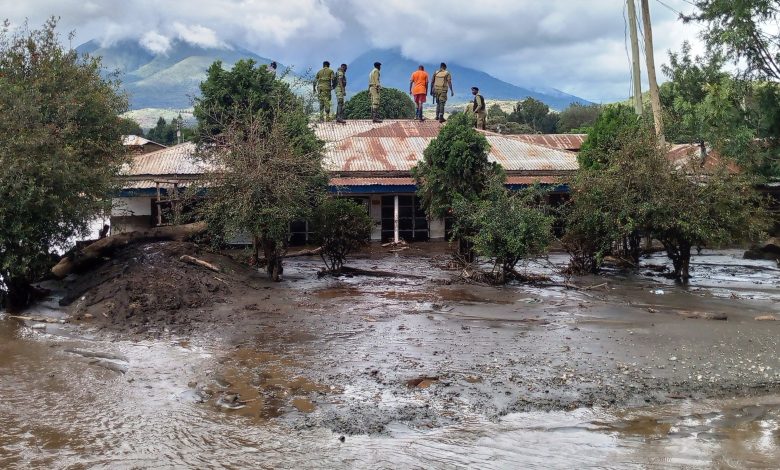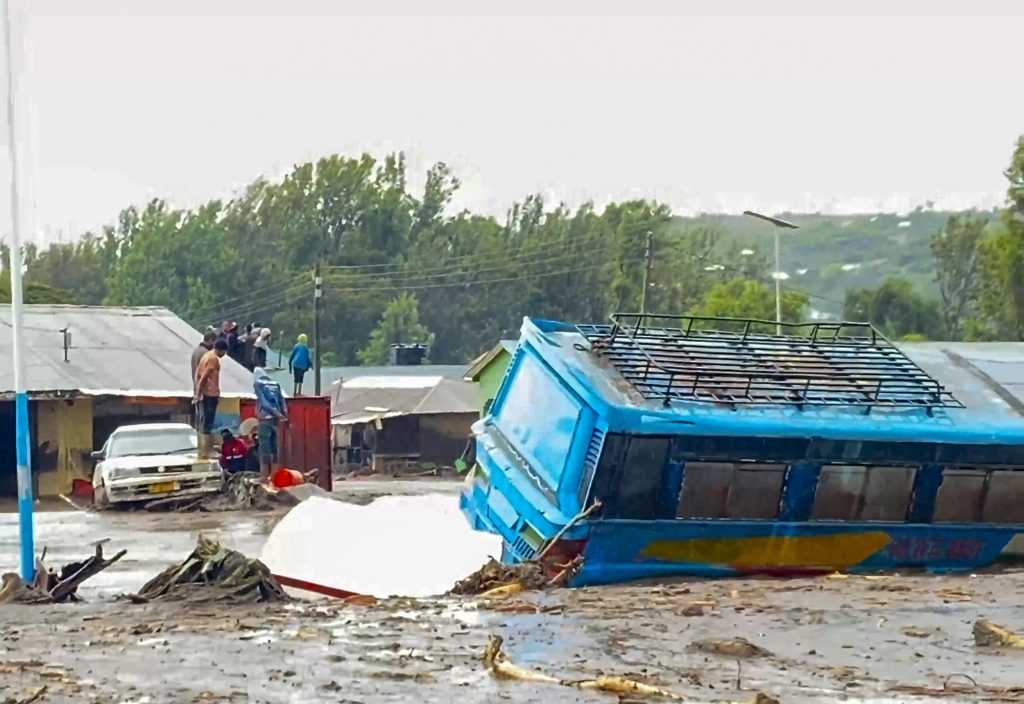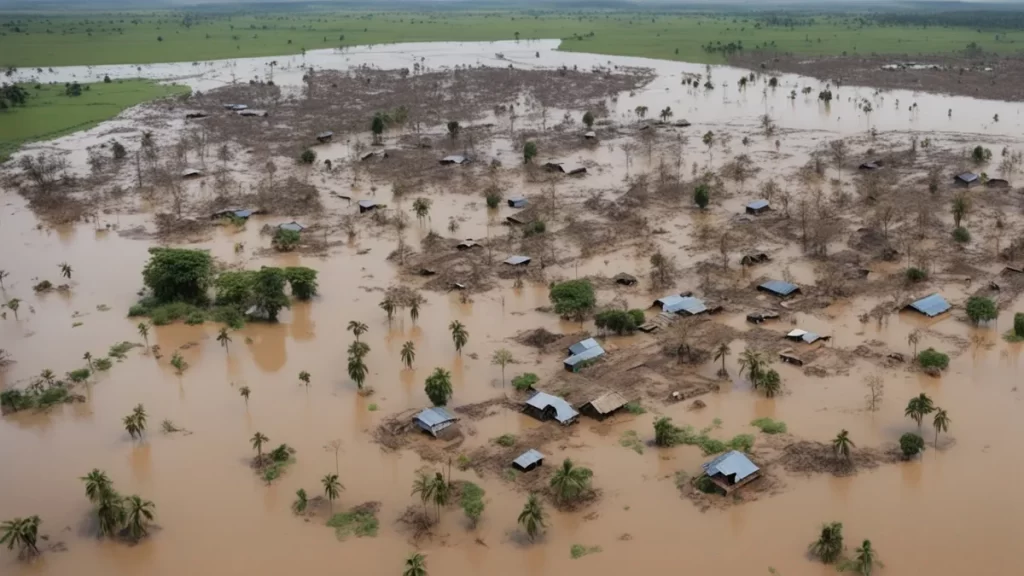Our article of November 17, 2023, with the headline “Tanzania’s 2023 El Niño Outlook: What to Expect and How to Prepare”, discusses the Tanzania Meteorological Authority’s (TMA) prediction of above-normal to average rainfall in various parts of Tanzania from October to December 2023, due to El Niño conditions. It emphasizes that this weather pattern will particularly affect areas with biannual rainfall. Hopefully, our government will have time to read our in-depth analysis.
Furthermore, the article details the efforts of the Tanzanian government and regional authorities in educating the public and preparing for potential heavy rains.
Apart from The Tanzania Meteorological Authority (TMA) announcing climate change, we are witnessing various events in different regions of the country. But the mudslide incident in the town of Katesh in Hanang District, Manyara Region, on December 3, 2023, has raised new alarms and left the residents in an indescribable state of sadness.
The mudslide was caused by heavy rains that had fallen in the area in the days leading up to the event. The mudslide killed more than 65 people, injured 117, and displaced 5,600 people, according to The Chief Government’s Spokesperson, Mr Mobhare Matinyi.
Quoted in the Daily News report, “The geologist from the Ministry of Mineral conducted a survey since the day of the incident (December 3 this year), and preliminary information shows that the source of the disaster was the collapse of part of the Mount Hanang that is featured with soft rocks that absorbed water and eventually causing a mudslide,” Mr Matinyi told the media in Manyara Region.
“After absorbing water, it created the compression that made some part of the mountain unable to withstand the compression and eventually part of it collapsed, sending tonnes of muddy waters that carried with it uprooted trees and rocks downstream towards Jordom River,” he explained.
Swift Response and Coordination
Local and Regional Committee Actions
The District and Regional Disaster Committees of Manyara, under Regional Commissioner Queen Sendiga’s leadership, demonstrated agility in promptly mobilising resources. These committees activated their emergency response plans, coordinating the deployment of search and rescue teams, medical personnel, and security forces.
This swift action ensured timely intervention and prevented further casualties. Establishment of Emergency Operations Centers both the District and Regional headquarters established Emergency Operations Centers (EOCs) to manage the response and coordinate relief efforts. These EOCs facilitated communication, information sharing, and resource allocation, ensuring a centralized and efficient response.
The local District Disaster Committee, working with the Regional Committee, took proactive measures in the early hours following the disaster. Their swift response involved establishing temporary shelters, providing medical aid to the injured and initiating search and rescue operations. These actions were crucial in the initial stages of managing the crisis.
Also, Effective communication played a pivotal role in the rapid response efforts where local and regional committees ensured seamless communication channels between different response units, enabling quick decision-making and resource allocation. This communication strategy facilitated a cohesive approach to addressing the immediate needs of the affected population.
Prompt Responses From Neighbouring Regions
Regional solidarity and cooperation recognised the magnitude of the disaster, and neighbouring regions, including Arusha, Singida, and Dodoma, responded promptly by extending a helping hand. The speed at which these regions mobilized resources showcased a sense of regional solidarity and cooperation. Medical experts, ambulances, and other critical resources were swiftly dispatched to the affected areas. The collaboration between regions ensured a comprehensive and well-rounded response, considering the multifaceted challenges posed by the mudslide.
In addition to that, a collaboration between the affected region and neighbouring areas was characterized by a coordinated and synchronized approach. This collaborative effort extended beyond immediate relief to demonstrating a commitment to supporting the affected communities throughout recovery.
The Immediate Impacts on the Communities
Loss of Life and Injury: The mudslide’s immediate impact was the tragic loss of lives of more than 65 people. This immense loss shattered families and communities, leaving a void that will never be truly filled. Additionally, the 117 individuals who sustained injuries faced physical and emotional trauma, requiring urgent medical attention and support.
Destruction of Homes and Livelihoods: The landslide caused extensive damage to infrastructure and property. Over 1,150 homes were destroyed, rendering thousands homeless and leaving them without essential belongings. This loss of shelter and possessions significantly impacted livelihoods, as many individuals relied on their homes for income generation.
Loss of Food Security: The mudslide disrupted agricultural activities and destroyed crops, jeopardizing food security for the affected communities. This immediate impact is further compounded by the displacement of families, making access to food and essential supplies even more challenging.
Mental Health and Psychosocial Stress: The trauma of witnessing such a devastating event can have profound and lasting consequences on mental health and well-being. Many survivors face anxiety, depression, and post-traumatic stress disorder (PTSD), requiring long-term psychosocial support to cope with their experiences.
Long-Term Impacts
Psychological Trauma and Mental Health: the trauma of witnessing the landslide and its aftermath will undoubtedly have lasting effects on the mental health of the affected communities. Survivors, especially children who may have lost family members or witnessed the destruction, will require sustained psychological support.
Economic Disruption and Livelihoods: the landslide has disrupted the financial activities of the affected communities, as homes, businesses, and agricultural lands have been destroyed. Many families have lost their sources of income, exacerbating poverty levels. A comprehensive economic recovery plan will be vital for rebuilding livelihoods and ensuring sustainable economic growth.
Infrastructure Rehabilitation: the landslide has taken a toll on critical infrastructure, including roads, bridges, and utilities. The government faces the challenge of restoring these essential services and implementing measures to prevent future disasters. Infrastructure rehabilitation will be a long-term endeavour requiring substantial financial and technical resources.
Government Initiative Towards The Incident
Seeking International Assistance
The Tanzanian government has actively sought international collaboration and support. Prime Minister Kassim Majaliwa Majaliwa’s appeal for assistance underscores the recognition that addressing the extensive impact of the landslide requires a collective effort. This collaborative approach reflects the government’s commitment to leveraging global resources and expertise for adequate recovery.
Financial Aid Management
The government has established the National Disaster Management Fund Electronic Account 9921151001 to streamline financial aid. This initiative ensures transparency and accountability in managing financial contributions, with specific directives from the Prime Minister on utilising funds for disaster-related expenses.
Infrastructure Rehabilitation
The government has prioritized rehabilitating critical infrastructure, including roads, bridges, and utilities. This not only involves restoring essential services but also implementing measures to enhance the resilience of infrastructure against future disasters. During a press conference held in Katesh on December 6, 2023, Tanzania’s Minister of Construction, Innocent Bashungwa, announced a unified effort to clear the Babati-Singida highway and other critical roads affected by the recent landslide. This initiative aims to restore uninterrupted travel and aid in the overall recovery process.
“We have come together as a team to ensure that road communication, especially on the Babati-Singida highway, is restored as quickly as possible,” stated Minister Bashungwa. “Clearing these roads is crucial to facilitate the movement of people and goods, which is essential for the recovery and rebuilding efforts in the affected areas.”
Economic Recovery Plan
The government is formulating an economic recovery plan to recognise the economic disruption caused by the landslide. This plan aims to revitalize local businesses, markets, and trade routes, fostering sustainable economic growth in the region. Supporting the affected communities in rebuilding their economic livelihoods is crucial to the government’s long-term strategy.
To deal with the impact of the heavy rains, President Samia Suluhu Hassan is cutting short her attendance at the COP28 climate summit in Dubai. She was among the dozens of world leaders who gathered at the significant UN summit to discuss tackling climate change.
President Samia stated that the government would cover the funeral expenses for all those who lost their lives in the landslide. Additionally, she directed all injured individuals currently undergoing treatment in various hospitals to receive proper medical care at the government’s expense.
“The government stands with the families who have lost loved ones in this tragic event,” President Samia said. “We are committed to providing them the support they need during this difficult time.”
In addition, the President has also directed the Regional Government and the Disaster Unit of the Prime Minister’s Office to ensure that all citizens whose homes have been washed away by water are given temporary shelter and that a detailed assessment of the disaster should be carried out with all Government units and institutions involved in the presence of the area incident and working day and night to ensure the situation returns to normal.
The Non-Governmental Organization Initiatives
Non-Governmental Organizations (NGOs) have played a crucial role in extending support to the communities affected by the mudslide in Manyara. Immediately following the disaster, numerous NGOs swiftly mobilized resources and personnel to provide essential aid. Organizations such as the Red Cross and Medicines Sans Frontiers (Doctors without Borders) set up medical camps, offering emergency healthcare services to the injured.
These medical teams addressed immediate health concerns and played a pivotal role in preventing the outbreak of diseases in the aftermath of the mudslide. NGOs have been instrumental in distributing relief supplies, including food, clean water, and shelter materials, ensuring that basic needs are met for those displaced by the disaster.
Furthermore, NGOs have actively participated in long-term recovery efforts. They have been involved in infrastructure rehabilitation projects, contributing expertise and resources to rebuild roads, bridges, and other essential facilities. NGOs specializing in community development have focused on economic recovery, assisting local businesses and farmers to help revive livelihoods.
Mental health support and trauma counselling services have also been initiated by NGOs to address the psychological impact on survivors. The collaborative efforts between governmental and non-governmental entities underline the importance of a unified approach to rebuilding and ensuring the sustained well-being of the affected communities in Manyara.
Lessons Learned
Vulnerability to Landslides: The disaster highlighted the susceptibility of Tanzania’s mountainous regions to landslides, particularly areas with soft rock formations and steep slopes. This vulnerability underscores the need for comprehensive risk assessments and proactive measures to prevent future disasters.
Importance of Preparedness: The prompt response by the government and local communities demonstrates the significance of pre-established disaster response plans, effective communication networks, and readily available resources. However, the scale of the disaster also reveals the need for further investment in preparedness measures, including early warning systems, evacuation drills, and public awareness campaigns.
Community Engagement: The effectiveness of the response and recovery efforts relied heavily on the involvement and collaboration of local communities. This highlights the crucial role of community engagement in disaster management, from needs assessment to implementation of relief and reconstruction projects.
Environmental Protection: The landslide underscores the link between environmental degradation and natural disasters. Unsustainable land use practices, deforestation, and soil erosion contribute to increased risks of landslides. Addressing these issues through environmental protection measures like afforestation and sustainable land management is essential for long-term resilience.
International Cooperation: The prompt response from neighbouring regions and the international community demonstrates the importance of collaboration in addressing large-scale disasters. This highlights the need for strengthened regional and international cooperation mechanisms to facilitate resource sharing, technical assistance, and knowledge exchange in disaster preparedness and response.
A Path Forward
Based on the lessons learned from the Katesh landslide, Tanzania can chart a path forward towards enhanced disaster resilience and preparedness:
Investing in Risk Reduction: Allocate resources for comprehensive risk assessments, early warning systems, land use planning, and infrastructure development in high-risk areas.
Strengthening Disaster Response Mechanisms: Enhance the capacity of disaster management agencies, equip them with modern technology, and conduct regular drills and training exercises.
Promoting Community-Based Preparedness: Encourage community engagement in disaster preparedness, build local knowledge and skills, and empower communities to lead their response and recovery efforts.
Prioritizing Environmental Protection: Implement sustainable land management practices, promote afforestation programs, and address environmental factors contributing to landslides and other natural disasters.
Building International Partnerships: Strengthen regional and international cooperation for disaster preparedness and response, facilitate resource sharing, and promote knowledge exchange and best practices.
A Call Action
The tragic mudslide incident in Manyara, Tanzania, is a poignant call to action for individuals, communities, and governments alike. It underscores the imperative of preparedness regarding early warning systems and comprehensive disaster response strategies. As we reflect on the lessons learned, let us collectively advocate for increased investment in technology, infrastructure, and community education to build resilience against future natural disasters.
Tanzanian authorities must continue fostering collaboration with non-governmental organizations and international partners. This collaboration can ensure that the affected communities receive sustained support in immediate relief efforts and long-term recovery and rebuilding initiatives. Individuals and communities can contribute by staying informed, participating in local disaster preparedness initiatives, and supporting organizations dedicated to disaster response and recovery.



